Business Environment Report: Sainsbury PLC and Economic Factors
VerifiedAdded on 2020/02/14
|19
|5980
|128
Report
AI Summary
This report provides a comprehensive analysis of the business environment impacting Sainsbury PLC. It begins with an overview of different organizational purposes, comparing Virgin Group Ltd, Sainsbury PLC, McDonalds, NHS England, and a local mobile repair shop. The report then examines how Sainsbury PLC meets the objectives of its various stakeholders, including investors, customers, and employees, highlighting the company's strategies and responsibilities. Task 2 delves into economic systems, such as free market, command, and mixed economies, and their impact on Sainsbury. It also analyzes the effects of fiscal and monetary policies on Sainsbury PLC, along with competition and regulatory mechanisms. Task 3 focuses on market structures, market forces, and the influence of the business and cultural environment on Sainsbury's behavior. Finally, Task 4 explores the significance of international trade, global factors, and the impact of European Union policies on Sainsbury PLC's operations and strategies. The report concludes with an overview of the key findings and their implications for Sainsbury PLC.
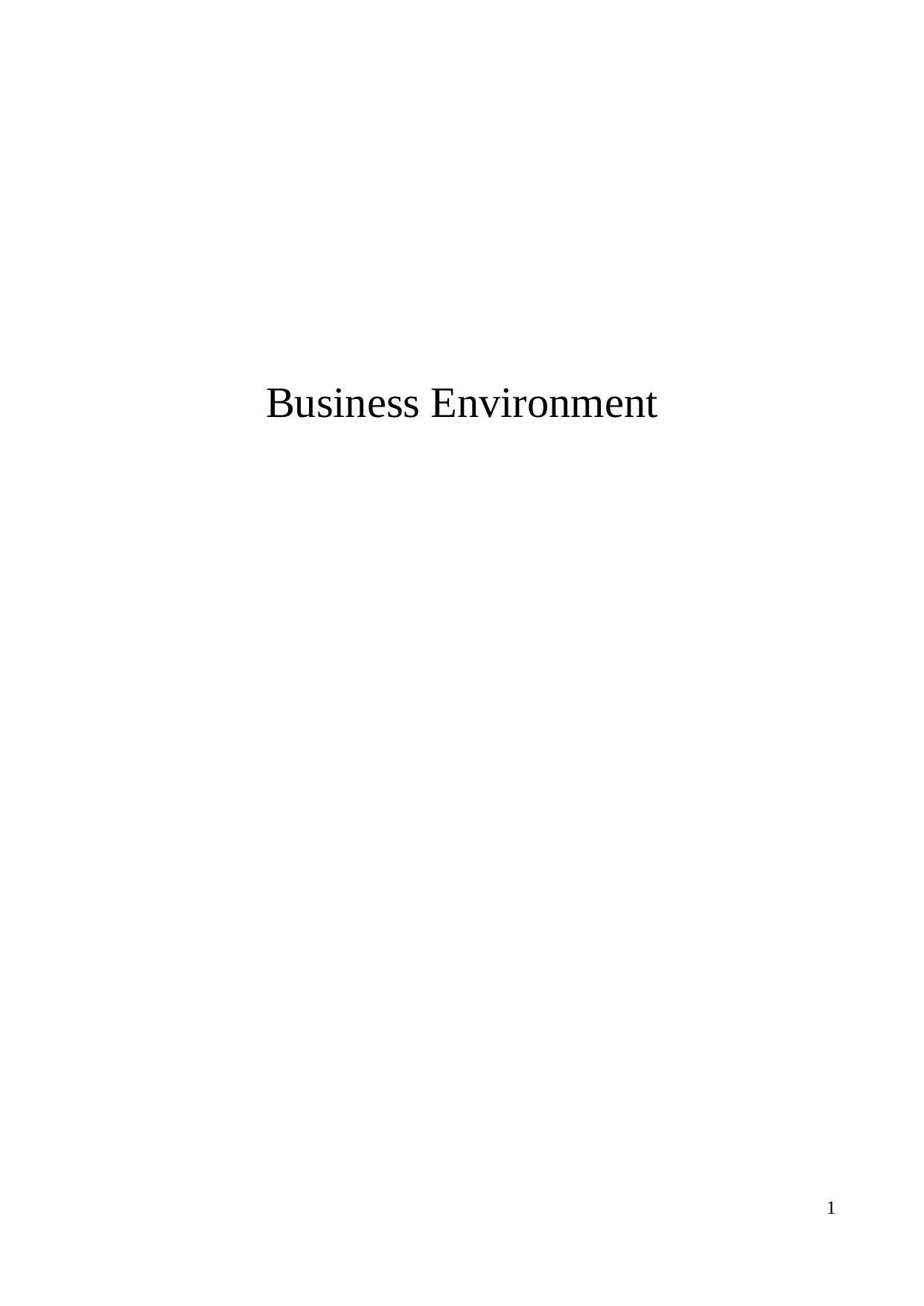
Business Environment
1
1
Paraphrase This Document
Need a fresh take? Get an instant paraphrase of this document with our AI Paraphraser
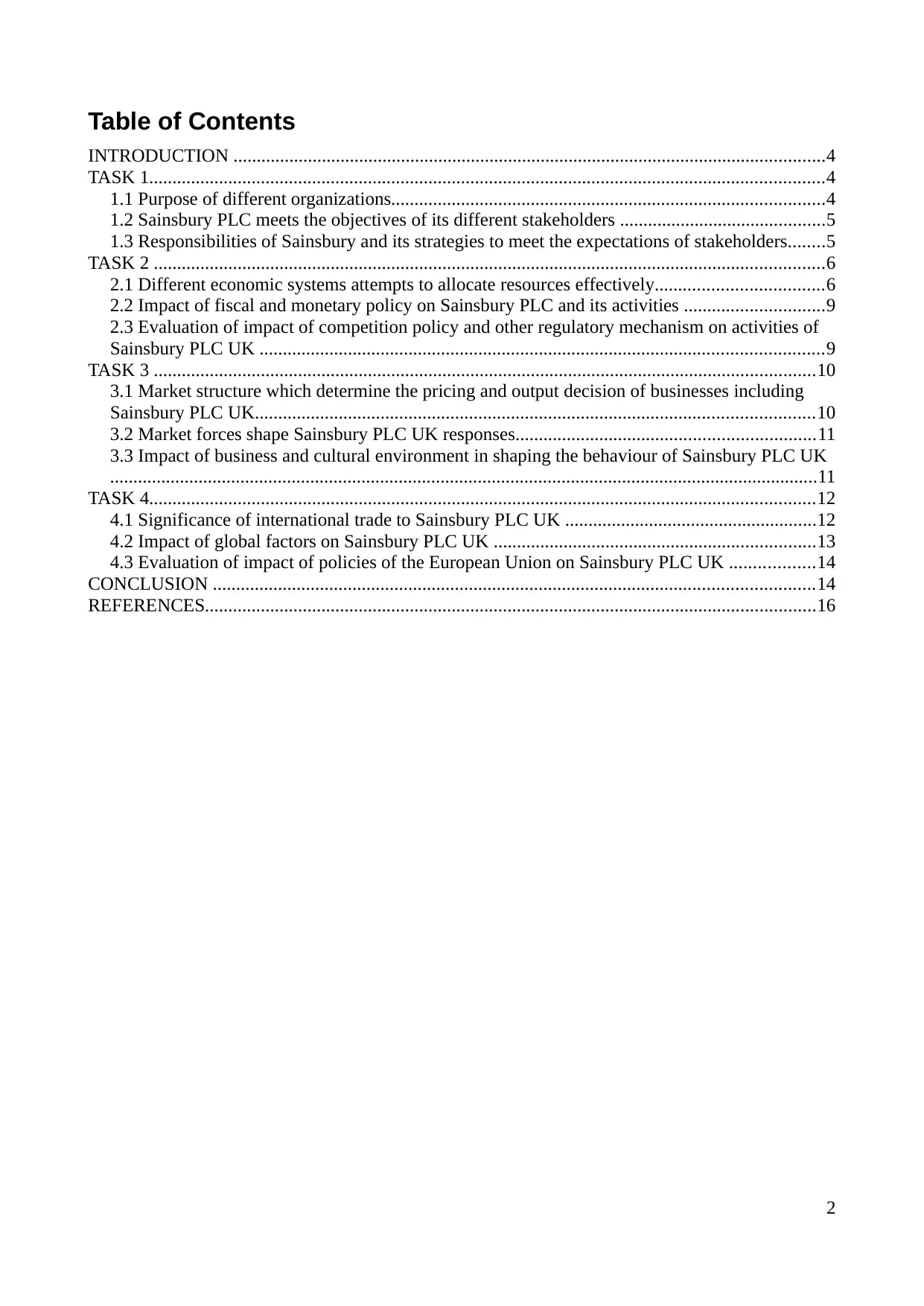
Table of Contents
INTRODUCTION ...............................................................................................................................4
TASK 1.................................................................................................................................................4
1.1 Purpose of different organizations.............................................................................................4
1.2 Sainsbury PLC meets the objectives of its different stakeholders ............................................5
1.3 Responsibilities of Sainsbury and its strategies to meet the expectations of stakeholders........5
TASK 2 ................................................................................................................................................6
2.1 Different economic systems attempts to allocate resources effectively....................................6
2.2 Impact of fiscal and monetary policy on Sainsbury PLC and its activities ..............................9
2.3 Evaluation of impact of competition policy and other regulatory mechanism on activities of
Sainsbury PLC UK .........................................................................................................................9
TASK 3 ..............................................................................................................................................10
3.1 Market structure which determine the pricing and output decision of businesses including
Sainsbury PLC UK........................................................................................................................10
3.2 Market forces shape Sainsbury PLC UK responses................................................................11
3.3 Impact of business and cultural environment in shaping the behaviour of Sainsbury PLC UK
........................................................................................................................................................11
TASK 4...............................................................................................................................................12
4.1 Significance of international trade to Sainsbury PLC UK ......................................................12
4.2 Impact of global factors on Sainsbury PLC UK .....................................................................13
4.3 Evaluation of impact of policies of the European Union on Sainsbury PLC UK ..................14
CONCLUSION .................................................................................................................................14
REFERENCES...................................................................................................................................16
2
INTRODUCTION ...............................................................................................................................4
TASK 1.................................................................................................................................................4
1.1 Purpose of different organizations.............................................................................................4
1.2 Sainsbury PLC meets the objectives of its different stakeholders ............................................5
1.3 Responsibilities of Sainsbury and its strategies to meet the expectations of stakeholders........5
TASK 2 ................................................................................................................................................6
2.1 Different economic systems attempts to allocate resources effectively....................................6
2.2 Impact of fiscal and monetary policy on Sainsbury PLC and its activities ..............................9
2.3 Evaluation of impact of competition policy and other regulatory mechanism on activities of
Sainsbury PLC UK .........................................................................................................................9
TASK 3 ..............................................................................................................................................10
3.1 Market structure which determine the pricing and output decision of businesses including
Sainsbury PLC UK........................................................................................................................10
3.2 Market forces shape Sainsbury PLC UK responses................................................................11
3.3 Impact of business and cultural environment in shaping the behaviour of Sainsbury PLC UK
........................................................................................................................................................11
TASK 4...............................................................................................................................................12
4.1 Significance of international trade to Sainsbury PLC UK ......................................................12
4.2 Impact of global factors on Sainsbury PLC UK .....................................................................13
4.3 Evaluation of impact of policies of the European Union on Sainsbury PLC UK ..................14
CONCLUSION .................................................................................................................................14
REFERENCES...................................................................................................................................16
2
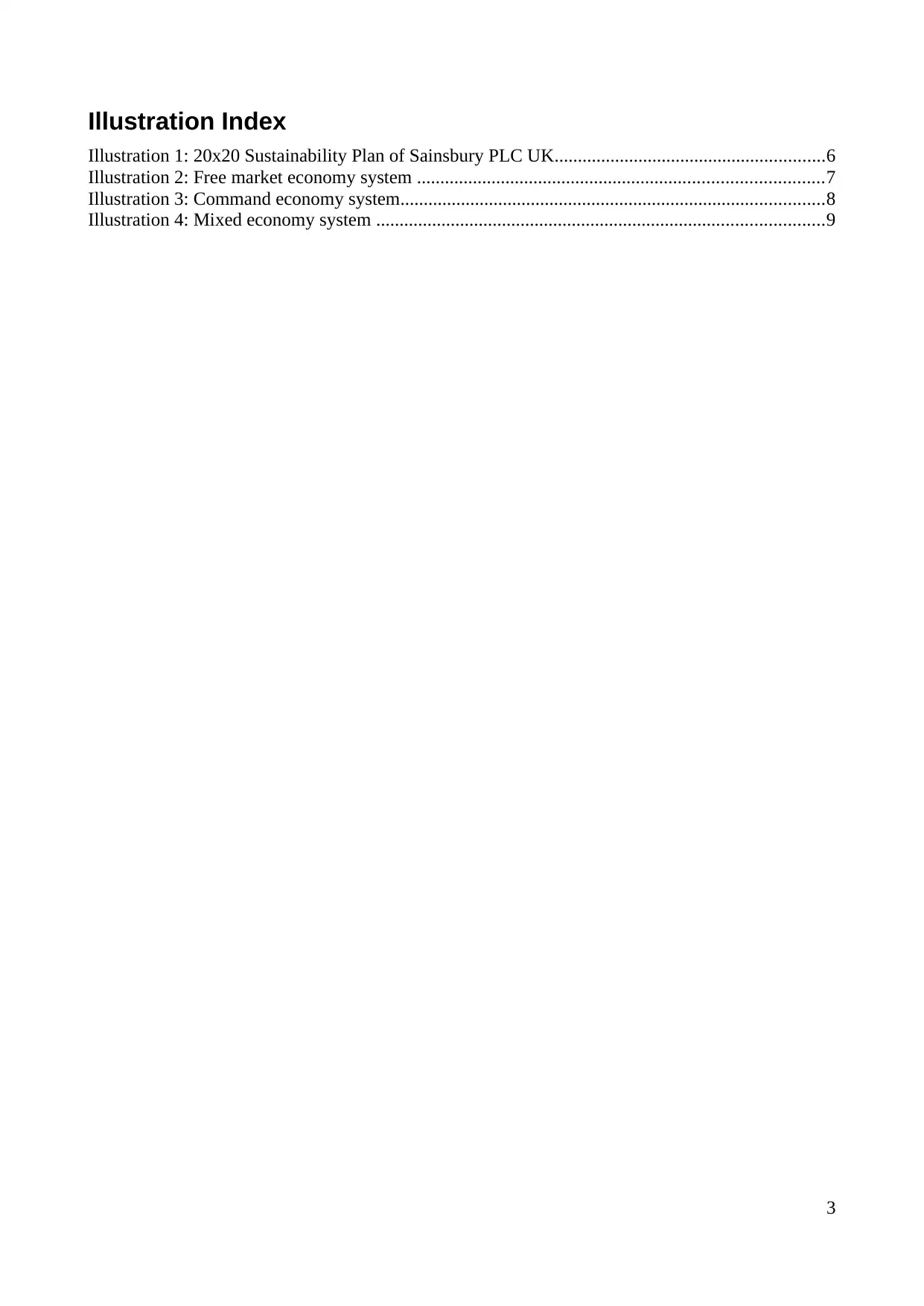
Illustration Index
Illustration 1: 20x20 Sustainability Plan of Sainsbury PLC UK..........................................................6
Illustration 2: Free market economy system .......................................................................................7
Illustration 3: Command economy system...........................................................................................8
Illustration 4: Mixed economy system ................................................................................................9
3
Illustration 1: 20x20 Sustainability Plan of Sainsbury PLC UK..........................................................6
Illustration 2: Free market economy system .......................................................................................7
Illustration 3: Command economy system...........................................................................................8
Illustration 4: Mixed economy system ................................................................................................9
3
⊘ This is a preview!⊘
Do you want full access?
Subscribe today to unlock all pages.

Trusted by 1+ million students worldwide
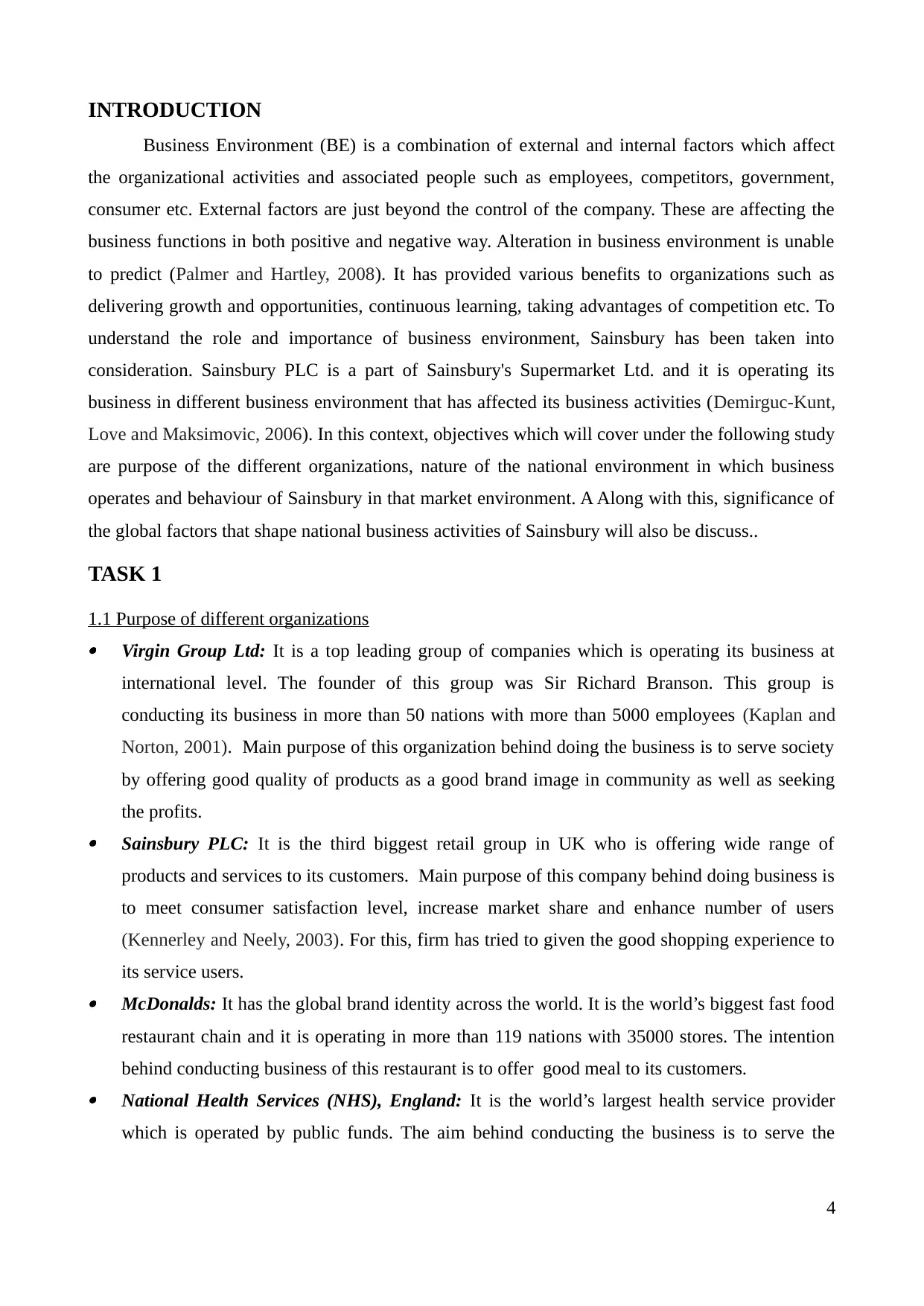
INTRODUCTION
Business Environment (BE) is a combination of external and internal factors which affect
the organizational activities and associated people such as employees, competitors, government,
consumer etc. External factors are just beyond the control of the company. These are affecting the
business functions in both positive and negative way. Alteration in business environment is unable
to predict (Palmer and Hartley, 2008). It has provided various benefits to organizations such as
delivering growth and opportunities, continuous learning, taking advantages of competition etc. To
understand the role and importance of business environment, Sainsbury has been taken into
consideration. Sainsbury PLC is a part of Sainsbury's Supermarket Ltd. and it is operating its
business in different business environment that has affected its business activities (Demirguc-Kunt,
Love and Maksimovic, 2006). In this context, objectives which will cover under the following study
are purpose of the different organizations, nature of the national environment in which business
operates and behaviour of Sainsbury in that market environment. A Along with this, significance of
the global factors that shape national business activities of Sainsbury will also be discuss..
TASK 1
1.1 Purpose of different organizations Virgin Group Ltd: It is a top leading group of companies which is operating its business at
international level. The founder of this group was Sir Richard Branson. This group is
conducting its business in more than 50 nations with more than 5000 employees (Kaplan and
Norton, 2001). Main purpose of this organization behind doing the business is to serve society
by offering good quality of products as a good brand image in community as well as seeking
the profits. Sainsbury PLC: It is the third biggest retail group in UK who is offering wide range of
products and services to its customers. Main purpose of this company behind doing business is
to meet consumer satisfaction level, increase market share and enhance number of users
(Kennerley and Neely, 2003). For this, firm has tried to given the good shopping experience to
its service users. McDonalds: It has the global brand identity across the world. It is the world’s biggest fast food
restaurant chain and it is operating in more than 119 nations with 35000 stores. The intention
behind conducting business of this restaurant is to offer good meal to its customers. National Health Services (NHS), England: It is the world’s largest health service provider
which is operated by public funds. The aim behind conducting the business is to serve the
4
Business Environment (BE) is a combination of external and internal factors which affect
the organizational activities and associated people such as employees, competitors, government,
consumer etc. External factors are just beyond the control of the company. These are affecting the
business functions in both positive and negative way. Alteration in business environment is unable
to predict (Palmer and Hartley, 2008). It has provided various benefits to organizations such as
delivering growth and opportunities, continuous learning, taking advantages of competition etc. To
understand the role and importance of business environment, Sainsbury has been taken into
consideration. Sainsbury PLC is a part of Sainsbury's Supermarket Ltd. and it is operating its
business in different business environment that has affected its business activities (Demirguc-Kunt,
Love and Maksimovic, 2006). In this context, objectives which will cover under the following study
are purpose of the different organizations, nature of the national environment in which business
operates and behaviour of Sainsbury in that market environment. A Along with this, significance of
the global factors that shape national business activities of Sainsbury will also be discuss..
TASK 1
1.1 Purpose of different organizations Virgin Group Ltd: It is a top leading group of companies which is operating its business at
international level. The founder of this group was Sir Richard Branson. This group is
conducting its business in more than 50 nations with more than 5000 employees (Kaplan and
Norton, 2001). Main purpose of this organization behind doing the business is to serve society
by offering good quality of products as a good brand image in community as well as seeking
the profits. Sainsbury PLC: It is the third biggest retail group in UK who is offering wide range of
products and services to its customers. Main purpose of this company behind doing business is
to meet consumer satisfaction level, increase market share and enhance number of users
(Kennerley and Neely, 2003). For this, firm has tried to given the good shopping experience to
its service users. McDonalds: It has the global brand identity across the world. It is the world’s biggest fast food
restaurant chain and it is operating in more than 119 nations with 35000 stores. The intention
behind conducting business of this restaurant is to offer good meal to its customers. National Health Services (NHS), England: It is the world’s largest health service provider
which is operated by public funds. The aim behind conducting the business is to serve the
4
Paraphrase This Document
Need a fresh take? Get an instant paraphrase of this document with our AI Paraphraser
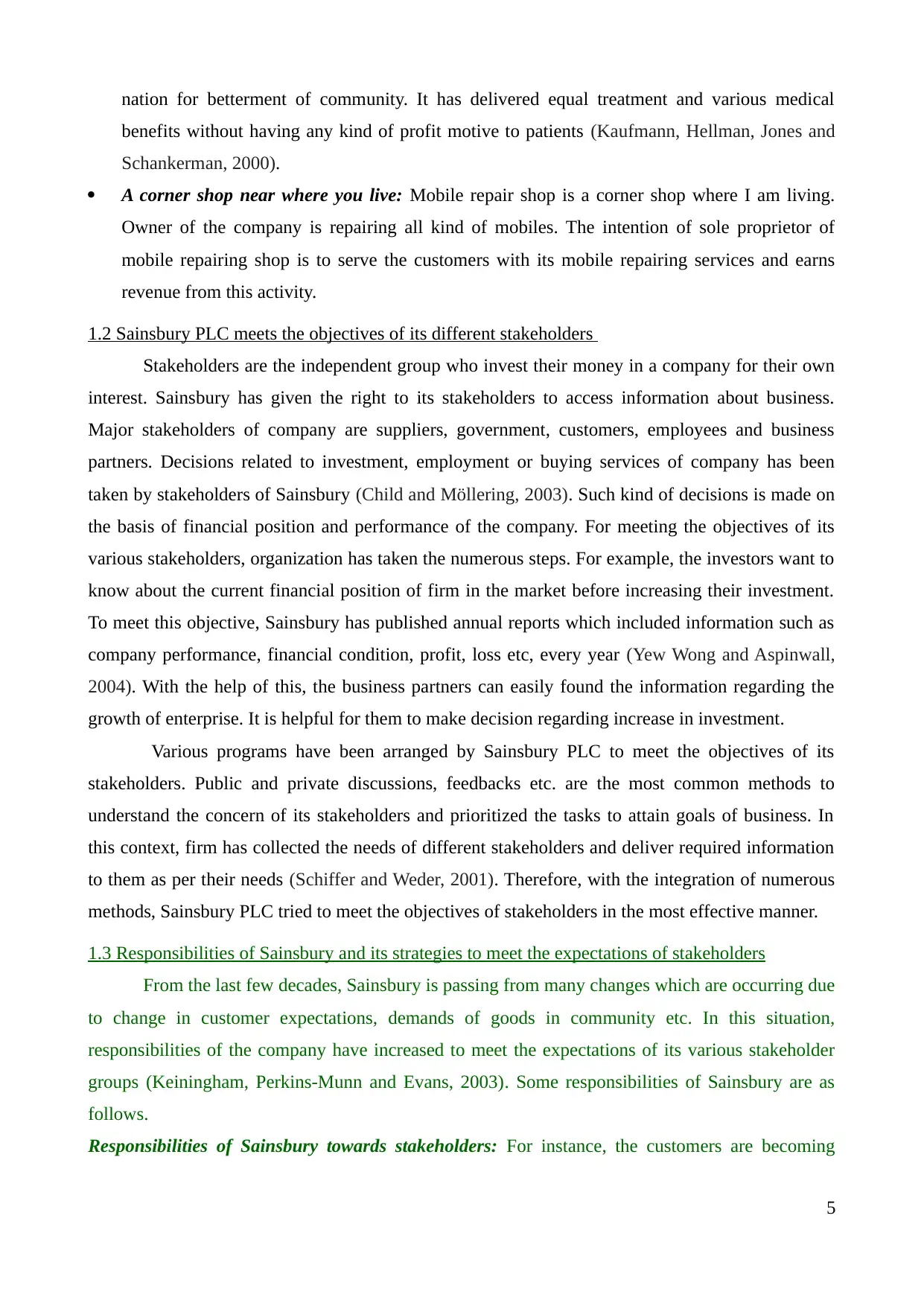
nation for betterment of community. It has delivered equal treatment and various medical
benefits without having any kind of profit motive to patients (Kaufmann, Hellman, Jones and
Schankerman, 2000).
A corner shop near where you live: Mobile repair shop is a corner shop where I am living.
Owner of the company is repairing all kind of mobiles. The intention of sole proprietor of
mobile repairing shop is to serve the customers with its mobile repairing services and earns
revenue from this activity.
1.2 Sainsbury PLC meets the objectives of its different stakeholders
Stakeholders are the independent group who invest their money in a company for their own
interest. Sainsbury has given the right to its stakeholders to access information about business.
Major stakeholders of company are suppliers, government, customers, employees and business
partners. Decisions related to investment, employment or buying services of company has been
taken by stakeholders of Sainsbury (Child and Möllering, 2003). Such kind of decisions is made on
the basis of financial position and performance of the company. For meeting the objectives of its
various stakeholders, organization has taken the numerous steps. For example, the investors want to
know about the current financial position of firm in the market before increasing their investment.
To meet this objective, Sainsbury has published annual reports which included information such as
company performance, financial condition, profit, loss etc, every year (Yew Wong and Aspinwall,
2004). With the help of this, the business partners can easily found the information regarding the
growth of enterprise. It is helpful for them to make decision regarding increase in investment.
Various programs have been arranged by Sainsbury PLC to meet the objectives of its
stakeholders. Public and private discussions, feedbacks etc. are the most common methods to
understand the concern of its stakeholders and prioritized the tasks to attain goals of business. In
this context, firm has collected the needs of different stakeholders and deliver required information
to them as per their needs (Schiffer and Weder, 2001). Therefore, with the integration of numerous
methods, Sainsbury PLC tried to meet the objectives of stakeholders in the most effective manner.
1.3 Responsibilities of Sainsbury and its strategies to meet the expectations of stakeholders
From the last few decades, Sainsbury is passing from many changes which are occurring due
to change in customer expectations, demands of goods in community etc. In this situation,
responsibilities of the company have increased to meet the expectations of its various stakeholder
groups (Keiningham, Perkins-Munn and Evans, 2003). Some responsibilities of Sainsbury are as
follows.
Responsibilities of Sainsbury towards stakeholders: For instance, the customers are becoming
5
benefits without having any kind of profit motive to patients (Kaufmann, Hellman, Jones and
Schankerman, 2000).
A corner shop near where you live: Mobile repair shop is a corner shop where I am living.
Owner of the company is repairing all kind of mobiles. The intention of sole proprietor of
mobile repairing shop is to serve the customers with its mobile repairing services and earns
revenue from this activity.
1.2 Sainsbury PLC meets the objectives of its different stakeholders
Stakeholders are the independent group who invest their money in a company for their own
interest. Sainsbury has given the right to its stakeholders to access information about business.
Major stakeholders of company are suppliers, government, customers, employees and business
partners. Decisions related to investment, employment or buying services of company has been
taken by stakeholders of Sainsbury (Child and Möllering, 2003). Such kind of decisions is made on
the basis of financial position and performance of the company. For meeting the objectives of its
various stakeholders, organization has taken the numerous steps. For example, the investors want to
know about the current financial position of firm in the market before increasing their investment.
To meet this objective, Sainsbury has published annual reports which included information such as
company performance, financial condition, profit, loss etc, every year (Yew Wong and Aspinwall,
2004). With the help of this, the business partners can easily found the information regarding the
growth of enterprise. It is helpful for them to make decision regarding increase in investment.
Various programs have been arranged by Sainsbury PLC to meet the objectives of its
stakeholders. Public and private discussions, feedbacks etc. are the most common methods to
understand the concern of its stakeholders and prioritized the tasks to attain goals of business. In
this context, firm has collected the needs of different stakeholders and deliver required information
to them as per their needs (Schiffer and Weder, 2001). Therefore, with the integration of numerous
methods, Sainsbury PLC tried to meet the objectives of stakeholders in the most effective manner.
1.3 Responsibilities of Sainsbury and its strategies to meet the expectations of stakeholders
From the last few decades, Sainsbury is passing from many changes which are occurring due
to change in customer expectations, demands of goods in community etc. In this situation,
responsibilities of the company have increased to meet the expectations of its various stakeholder
groups (Keiningham, Perkins-Munn and Evans, 2003). Some responsibilities of Sainsbury are as
follows.
Responsibilities of Sainsbury towards stakeholders: For instance, the customers are becoming
5
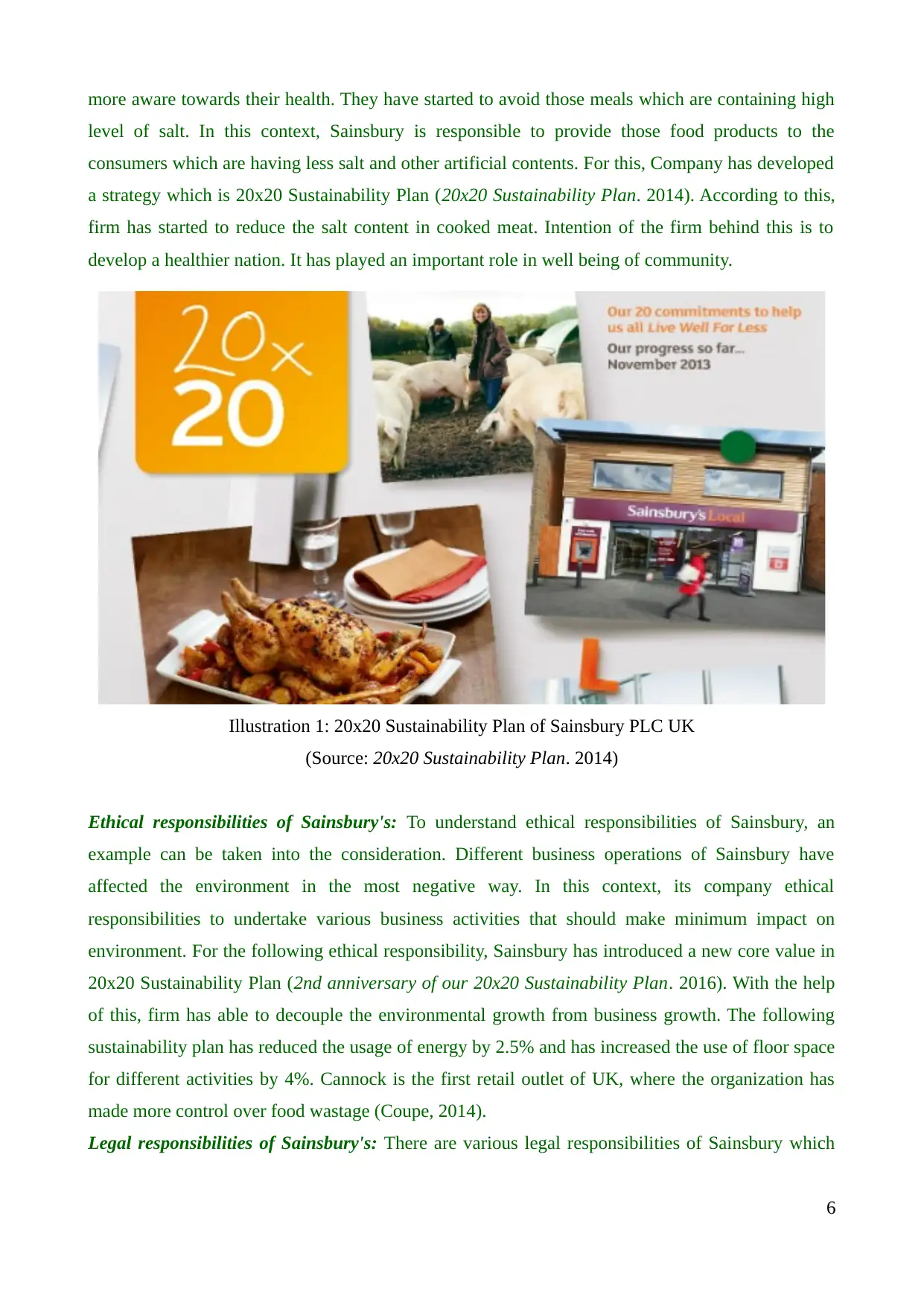
more aware towards their health. They have started to avoid those meals which are containing high
level of salt. In this context, Sainsbury is responsible to provide those food products to the
consumers which are having less salt and other artificial contents. For this, Company has developed
a strategy which is 20x20 Sustainability Plan (20x20 Sustainability Plan. 2014). According to this,
firm has started to reduce the salt content in cooked meat. Intention of the firm behind this is to
develop a healthier nation. It has played an important role in well being of community.
Ethical responsibilities of Sainsbury's: To understand ethical responsibilities of Sainsbury, an
example can be taken into the consideration. Different business operations of Sainsbury have
affected the environment in the most negative way. In this context, its company ethical
responsibilities to undertake various business activities that should make minimum impact on
environment. For the following ethical responsibility, Sainsbury has introduced a new core value in
20x20 Sustainability Plan (2nd anniversary of our 20x20 Sustainability Plan. 2016). With the help
of this, firm has able to decouple the environmental growth from business growth. The following
sustainability plan has reduced the usage of energy by 2.5% and has increased the use of floor space
for different activities by 4%. Cannock is the first retail outlet of UK, where the organization has
made more control over food wastage (Coupe, 2014).
Legal responsibilities of Sainsbury's: There are various legal responsibilities of Sainsbury which
6
Illustration 1: 20x20 Sustainability Plan of Sainsbury PLC UK
(Source: 20x20 Sustainability Plan. 2014)
level of salt. In this context, Sainsbury is responsible to provide those food products to the
consumers which are having less salt and other artificial contents. For this, Company has developed
a strategy which is 20x20 Sustainability Plan (20x20 Sustainability Plan. 2014). According to this,
firm has started to reduce the salt content in cooked meat. Intention of the firm behind this is to
develop a healthier nation. It has played an important role in well being of community.
Ethical responsibilities of Sainsbury's: To understand ethical responsibilities of Sainsbury, an
example can be taken into the consideration. Different business operations of Sainsbury have
affected the environment in the most negative way. In this context, its company ethical
responsibilities to undertake various business activities that should make minimum impact on
environment. For the following ethical responsibility, Sainsbury has introduced a new core value in
20x20 Sustainability Plan (2nd anniversary of our 20x20 Sustainability Plan. 2016). With the help
of this, firm has able to decouple the environmental growth from business growth. The following
sustainability plan has reduced the usage of energy by 2.5% and has increased the use of floor space
for different activities by 4%. Cannock is the first retail outlet of UK, where the organization has
made more control over food wastage (Coupe, 2014).
Legal responsibilities of Sainsbury's: There are various legal responsibilities of Sainsbury which
6
Illustration 1: 20x20 Sustainability Plan of Sainsbury PLC UK
(Source: 20x20 Sustainability Plan. 2014)
⊘ This is a preview!⊘
Do you want full access?
Subscribe today to unlock all pages.

Trusted by 1+ million students worldwide
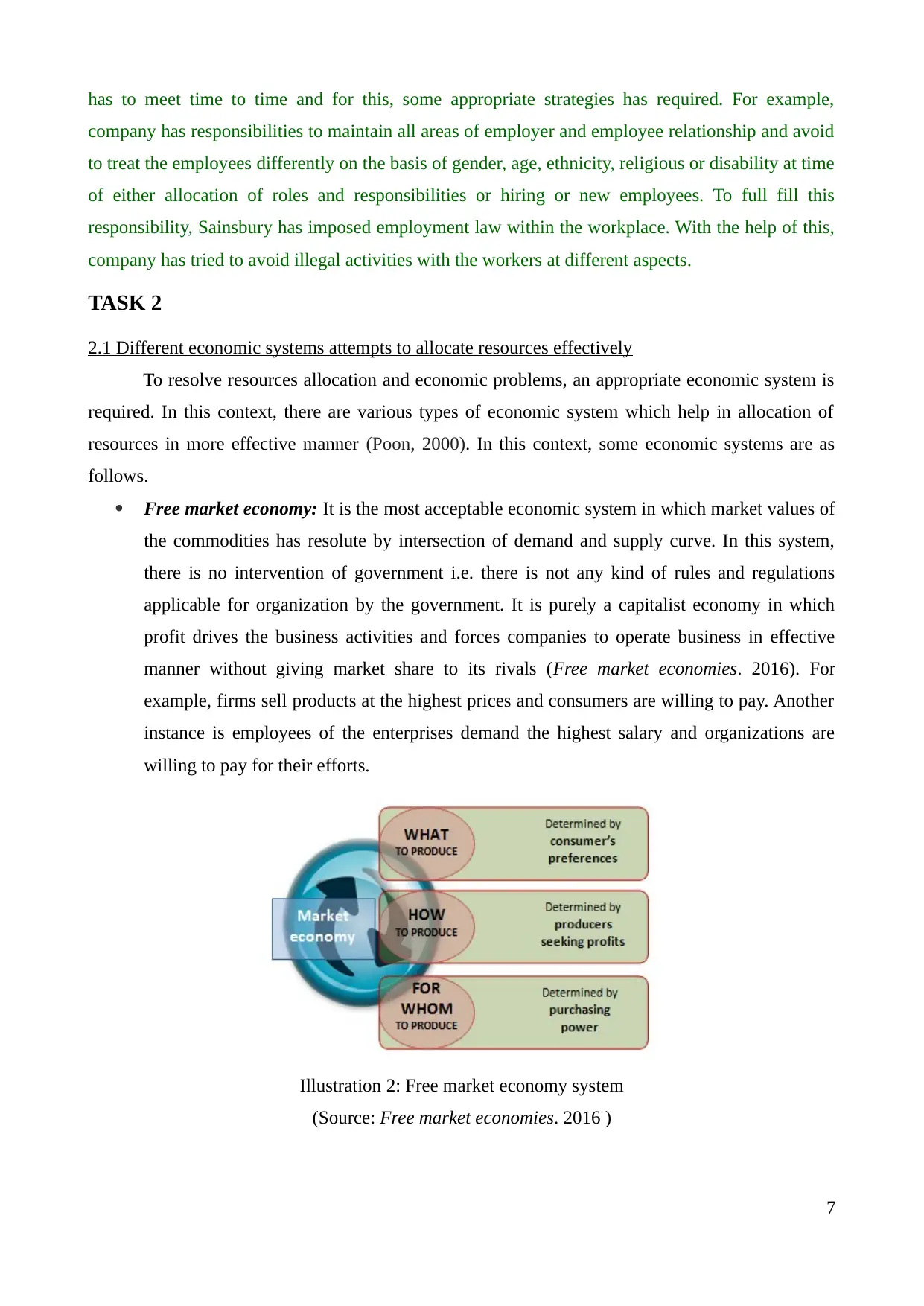
has to meet time to time and for this, some appropriate strategies has required. For example,
company has responsibilities to maintain all areas of employer and employee relationship and avoid
to treat the employees differently on the basis of gender, age, ethnicity, religious or disability at time
of either allocation of roles and responsibilities or hiring or new employees. To full fill this
responsibility, Sainsbury has imposed employment law within the workplace. With the help of this,
company has tried to avoid illegal activities with the workers at different aspects.
TASK 2
2.1 Different economic systems attempts to allocate resources effectively
To resolve resources allocation and economic problems, an appropriate economic system is
required. In this context, there are various types of economic system which help in allocation of
resources in more effective manner (Poon, 2000). In this context, some economic systems are as
follows.
Free market economy: It is the most acceptable economic system in which market values of
the commodities has resolute by intersection of demand and supply curve. In this system,
there is no intervention of government i.e. there is not any kind of rules and regulations
applicable for organization by the government. It is purely a capitalist economy in which
profit drives the business activities and forces companies to operate business in effective
manner without giving market share to its rivals (Free market economies. 2016). For
example, firms sell products at the highest prices and consumers are willing to pay. Another
instance is employees of the enterprises demand the highest salary and organizations are
willing to pay for their efforts.
7
Illustration 2: Free market economy system
(Source: Free market economies. 2016 )
company has responsibilities to maintain all areas of employer and employee relationship and avoid
to treat the employees differently on the basis of gender, age, ethnicity, religious or disability at time
of either allocation of roles and responsibilities or hiring or new employees. To full fill this
responsibility, Sainsbury has imposed employment law within the workplace. With the help of this,
company has tried to avoid illegal activities with the workers at different aspects.
TASK 2
2.1 Different economic systems attempts to allocate resources effectively
To resolve resources allocation and economic problems, an appropriate economic system is
required. In this context, there are various types of economic system which help in allocation of
resources in more effective manner (Poon, 2000). In this context, some economic systems are as
follows.
Free market economy: It is the most acceptable economic system in which market values of
the commodities has resolute by intersection of demand and supply curve. In this system,
there is no intervention of government i.e. there is not any kind of rules and regulations
applicable for organization by the government. It is purely a capitalist economy in which
profit drives the business activities and forces companies to operate business in effective
manner without giving market share to its rivals (Free market economies. 2016). For
example, firms sell products at the highest prices and consumers are willing to pay. Another
instance is employees of the enterprises demand the highest salary and organizations are
willing to pay for their efforts.
7
Illustration 2: Free market economy system
(Source: Free market economies. 2016 )
Paraphrase This Document
Need a fresh take? Get an instant paraphrase of this document with our AI Paraphraser
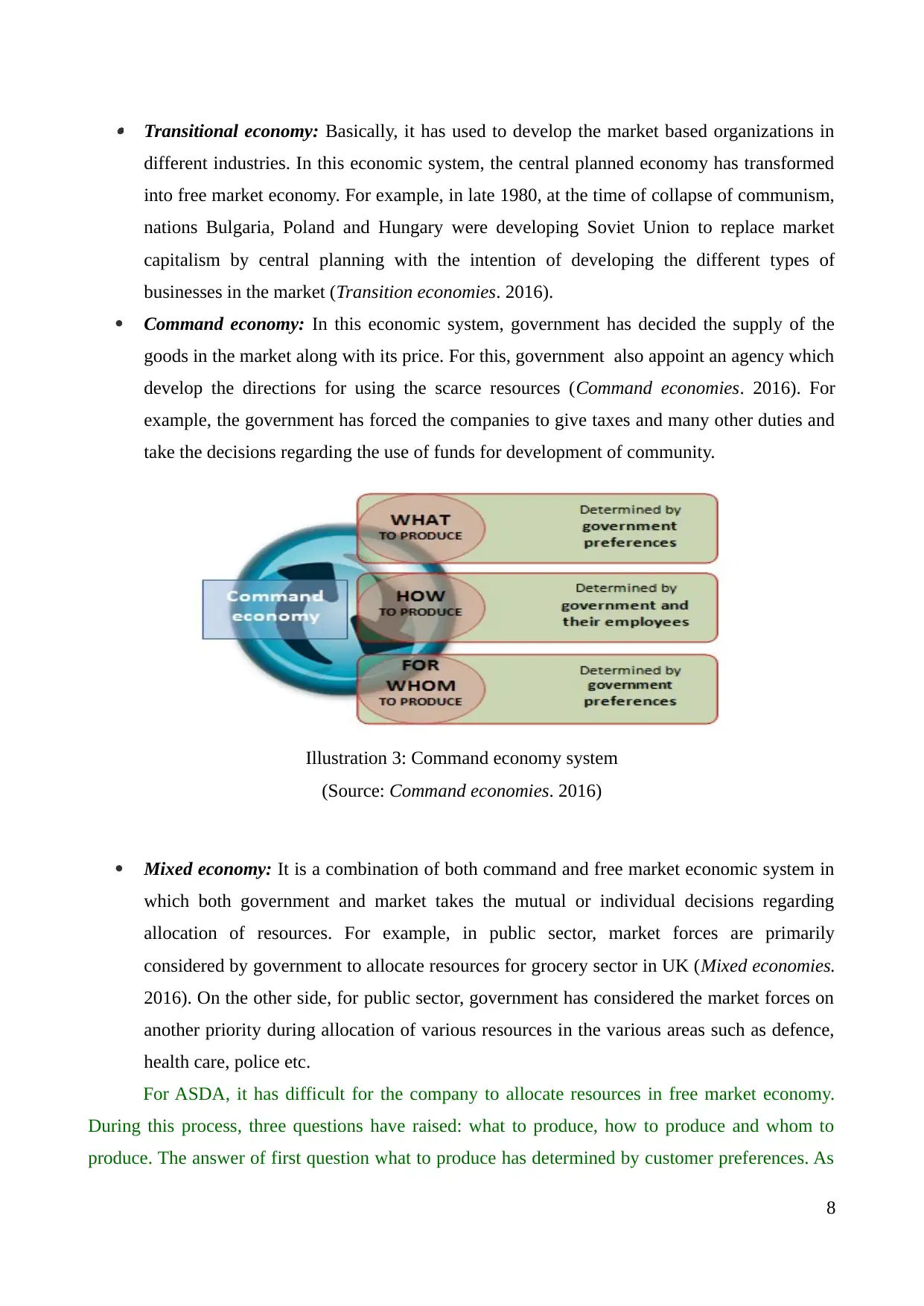
Transitional economy: Basically, it has used to develop the market based organizations in
different industries. In this economic system, the central planned economy has transformed
into free market economy. For example, in late 1980, at the time of collapse of communism,
nations Bulgaria, Poland and Hungary were developing Soviet Union to replace market
capitalism by central planning with the intention of developing the different types of
businesses in the market (Transition economies. 2016).
Command economy: In this economic system, government has decided the supply of the
goods in the market along with its price. For this, government also appoint an agency which
develop the directions for using the scarce resources (Command economies. 2016). For
example, the government has forced the companies to give taxes and many other duties and
take the decisions regarding the use of funds for development of community.
Mixed economy: It is a combination of both command and free market economic system in
which both government and market takes the mutual or individual decisions regarding
allocation of resources. For example, in public sector, market forces are primarily
considered by government to allocate resources for grocery sector in UK (Mixed economies.
2016). On the other side, for public sector, government has considered the market forces on
another priority during allocation of various resources in the various areas such as defence,
health care, police etc.
For ASDA, it has difficult for the company to allocate resources in free market economy.
During this process, three questions have raised: what to produce, how to produce and whom to
produce. The answer of first question what to produce has determined by customer preferences. As
8
Illustration 3: Command economy system
(Source: Command economies. 2016)
different industries. In this economic system, the central planned economy has transformed
into free market economy. For example, in late 1980, at the time of collapse of communism,
nations Bulgaria, Poland and Hungary were developing Soviet Union to replace market
capitalism by central planning with the intention of developing the different types of
businesses in the market (Transition economies. 2016).
Command economy: In this economic system, government has decided the supply of the
goods in the market along with its price. For this, government also appoint an agency which
develop the directions for using the scarce resources (Command economies. 2016). For
example, the government has forced the companies to give taxes and many other duties and
take the decisions regarding the use of funds for development of community.
Mixed economy: It is a combination of both command and free market economic system in
which both government and market takes the mutual or individual decisions regarding
allocation of resources. For example, in public sector, market forces are primarily
considered by government to allocate resources for grocery sector in UK (Mixed economies.
2016). On the other side, for public sector, government has considered the market forces on
another priority during allocation of various resources in the various areas such as defence,
health care, police etc.
For ASDA, it has difficult for the company to allocate resources in free market economy.
During this process, three questions have raised: what to produce, how to produce and whom to
produce. The answer of first question what to produce has determined by customer preferences. As
8
Illustration 3: Command economy system
(Source: Command economies. 2016)
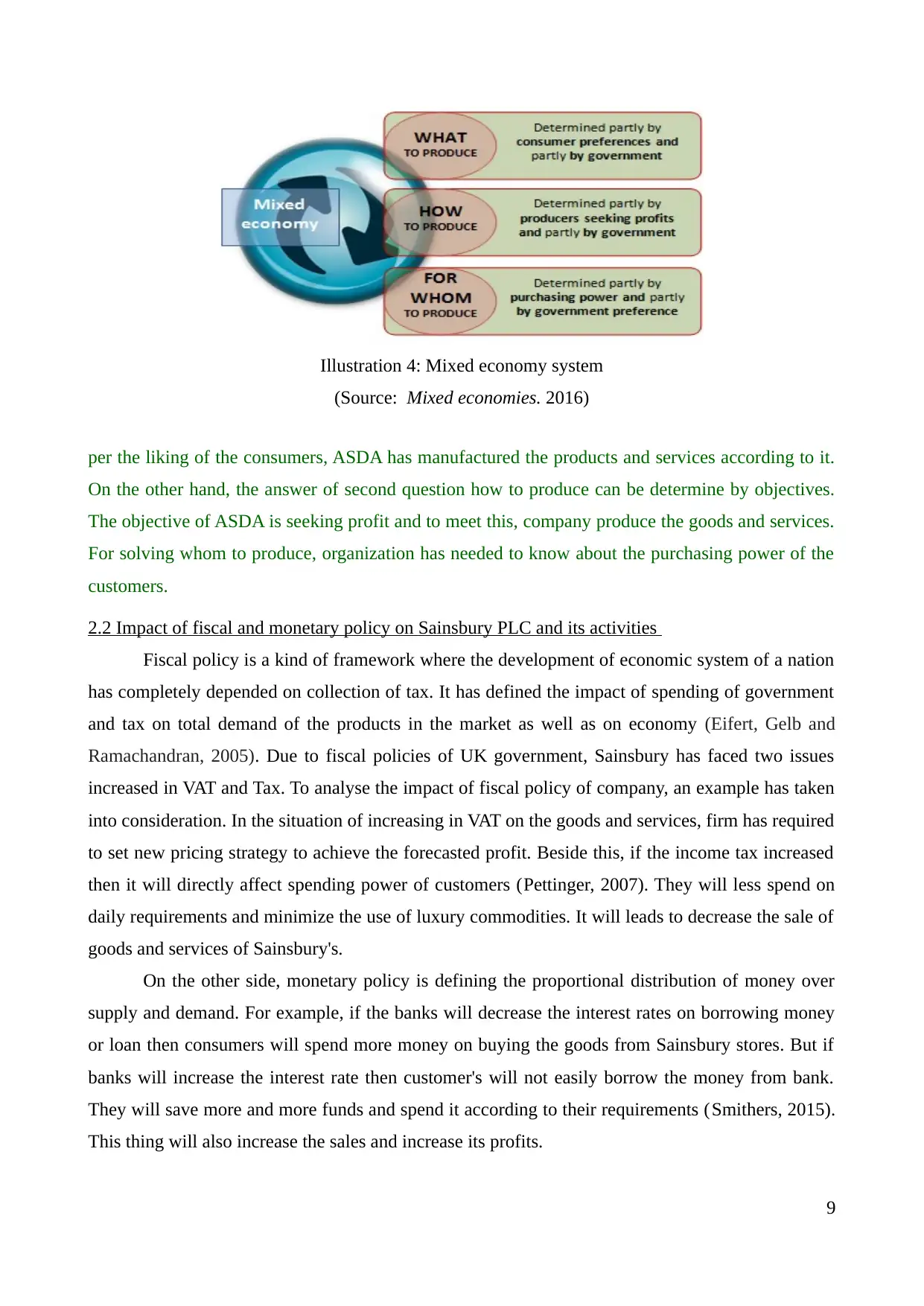
per the liking of the consumers, ASDA has manufactured the products and services according to it.
On the other hand, the answer of second question how to produce can be determine by objectives.
The objective of ASDA is seeking profit and to meet this, company produce the goods and services.
For solving whom to produce, organization has needed to know about the purchasing power of the
customers.
2.2 Impact of fiscal and monetary policy on Sainsbury PLC and its activities
Fiscal policy is a kind of framework where the development of economic system of a nation
has completely depended on collection of tax. It has defined the impact of spending of government
and tax on total demand of the products in the market as well as on economy (Eifert, Gelb and
Ramachandran, 2005). Due to fiscal policies of UK government, Sainsbury has faced two issues
increased in VAT and Tax. To analyse the impact of fiscal policy of company, an example has taken
into consideration. In the situation of increasing in VAT on the goods and services, firm has required
to set new pricing strategy to achieve the forecasted profit. Beside this, if the income tax increased
then it will directly affect spending power of customers (Pettinger, 2007). They will less spend on
daily requirements and minimize the use of luxury commodities. It will leads to decrease the sale of
goods and services of Sainsbury's.
On the other side, monetary policy is defining the proportional distribution of money over
supply and demand. For example, if the banks will decrease the interest rates on borrowing money
or loan then consumers will spend more money on buying the goods from Sainsbury stores. But if
banks will increase the interest rate then customer's will not easily borrow the money from bank.
They will save more and more funds and spend it according to their requirements (Smithers, 2015).
This thing will also increase the sales and increase its profits.
9
Illustration 4: Mixed economy system
(Source: Mixed economies. 2016)
On the other hand, the answer of second question how to produce can be determine by objectives.
The objective of ASDA is seeking profit and to meet this, company produce the goods and services.
For solving whom to produce, organization has needed to know about the purchasing power of the
customers.
2.2 Impact of fiscal and monetary policy on Sainsbury PLC and its activities
Fiscal policy is a kind of framework where the development of economic system of a nation
has completely depended on collection of tax. It has defined the impact of spending of government
and tax on total demand of the products in the market as well as on economy (Eifert, Gelb and
Ramachandran, 2005). Due to fiscal policies of UK government, Sainsbury has faced two issues
increased in VAT and Tax. To analyse the impact of fiscal policy of company, an example has taken
into consideration. In the situation of increasing in VAT on the goods and services, firm has required
to set new pricing strategy to achieve the forecasted profit. Beside this, if the income tax increased
then it will directly affect spending power of customers (Pettinger, 2007). They will less spend on
daily requirements and minimize the use of luxury commodities. It will leads to decrease the sale of
goods and services of Sainsbury's.
On the other side, monetary policy is defining the proportional distribution of money over
supply and demand. For example, if the banks will decrease the interest rates on borrowing money
or loan then consumers will spend more money on buying the goods from Sainsbury stores. But if
banks will increase the interest rate then customer's will not easily borrow the money from bank.
They will save more and more funds and spend it according to their requirements (Smithers, 2015).
This thing will also increase the sales and increase its profits.
9
Illustration 4: Mixed economy system
(Source: Mixed economies. 2016)
⊘ This is a preview!⊘
Do you want full access?
Subscribe today to unlock all pages.

Trusted by 1+ million students worldwide
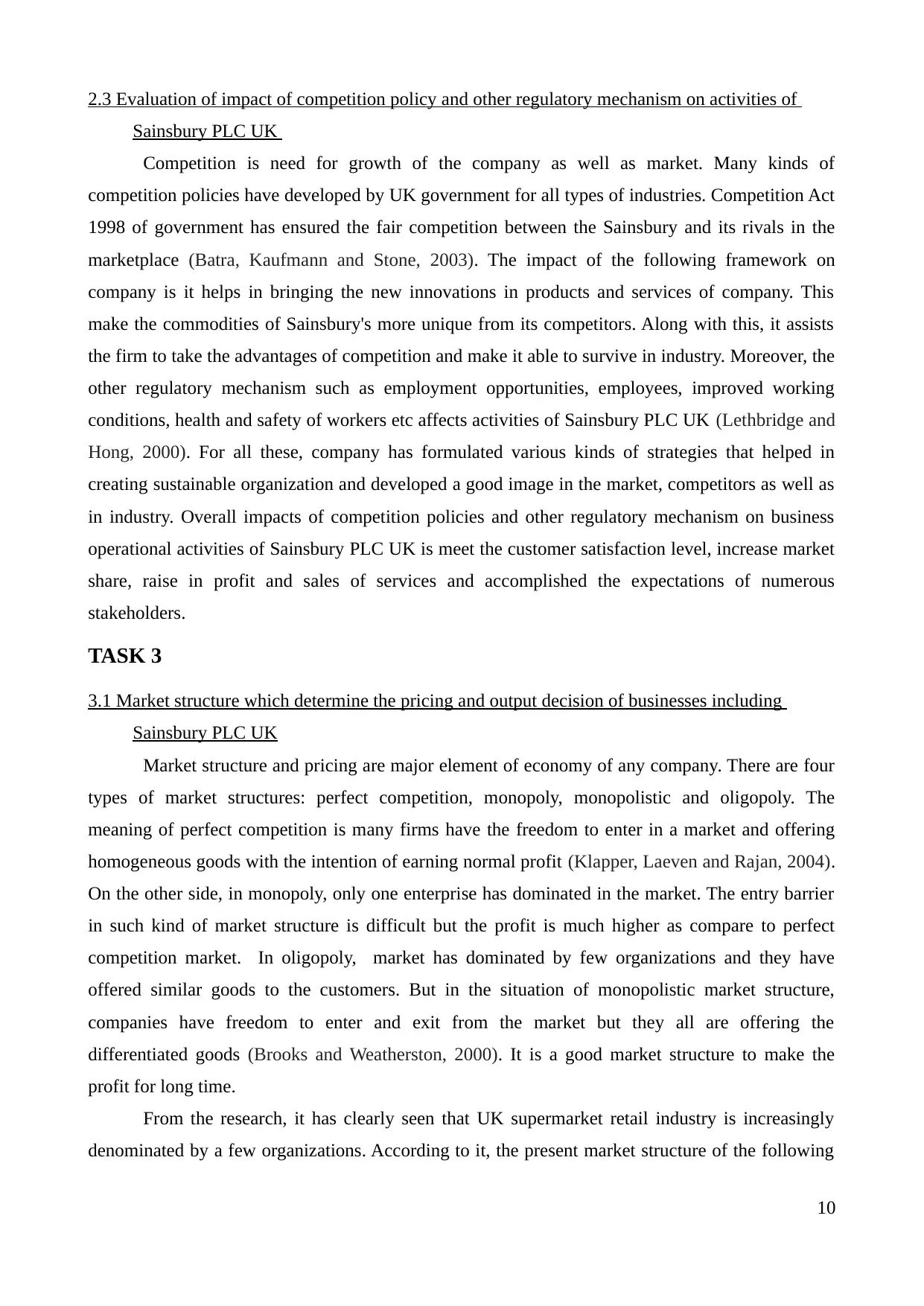
2.3 Evaluation of impact of competition policy and other regulatory mechanism on activities of
Sainsbury PLC UK
Competition is need for growth of the company as well as market. Many kinds of
competition policies have developed by UK government for all types of industries. Competition Act
1998 of government has ensured the fair competition between the Sainsbury and its rivals in the
marketplace (Batra, Kaufmann and Stone, 2003). The impact of the following framework on
company is it helps in bringing the new innovations in products and services of company. This
make the commodities of Sainsbury's more unique from its competitors. Along with this, it assists
the firm to take the advantages of competition and make it able to survive in industry. Moreover, the
other regulatory mechanism such as employment opportunities, employees, improved working
conditions, health and safety of workers etc affects activities of Sainsbury PLC UK (Lethbridge and
Hong, 2000). For all these, company has formulated various kinds of strategies that helped in
creating sustainable organization and developed a good image in the market, competitors as well as
in industry. Overall impacts of competition policies and other regulatory mechanism on business
operational activities of Sainsbury PLC UK is meet the customer satisfaction level, increase market
share, raise in profit and sales of services and accomplished the expectations of numerous
stakeholders.
TASK 3
3.1 Market structure which determine the pricing and output decision of businesses including
Sainsbury PLC UK
Market structure and pricing are major element of economy of any company. There are four
types of market structures: perfect competition, monopoly, monopolistic and oligopoly. The
meaning of perfect competition is many firms have the freedom to enter in a market and offering
homogeneous goods with the intention of earning normal profit (Klapper, Laeven and Rajan, 2004).
On the other side, in monopoly, only one enterprise has dominated in the market. The entry barrier
in such kind of market structure is difficult but the profit is much higher as compare to perfect
competition market. In oligopoly, market has dominated by few organizations and they have
offered similar goods to the customers. But in the situation of monopolistic market structure,
companies have freedom to enter and exit from the market but they all are offering the
differentiated goods (Brooks and Weatherston, 2000). It is a good market structure to make the
profit for long time.
From the research, it has clearly seen that UK supermarket retail industry is increasingly
denominated by a few organizations. According to it, the present market structure of the following
10
Sainsbury PLC UK
Competition is need for growth of the company as well as market. Many kinds of
competition policies have developed by UK government for all types of industries. Competition Act
1998 of government has ensured the fair competition between the Sainsbury and its rivals in the
marketplace (Batra, Kaufmann and Stone, 2003). The impact of the following framework on
company is it helps in bringing the new innovations in products and services of company. This
make the commodities of Sainsbury's more unique from its competitors. Along with this, it assists
the firm to take the advantages of competition and make it able to survive in industry. Moreover, the
other regulatory mechanism such as employment opportunities, employees, improved working
conditions, health and safety of workers etc affects activities of Sainsbury PLC UK (Lethbridge and
Hong, 2000). For all these, company has formulated various kinds of strategies that helped in
creating sustainable organization and developed a good image in the market, competitors as well as
in industry. Overall impacts of competition policies and other regulatory mechanism on business
operational activities of Sainsbury PLC UK is meet the customer satisfaction level, increase market
share, raise in profit and sales of services and accomplished the expectations of numerous
stakeholders.
TASK 3
3.1 Market structure which determine the pricing and output decision of businesses including
Sainsbury PLC UK
Market structure and pricing are major element of economy of any company. There are four
types of market structures: perfect competition, monopoly, monopolistic and oligopoly. The
meaning of perfect competition is many firms have the freedom to enter in a market and offering
homogeneous goods with the intention of earning normal profit (Klapper, Laeven and Rajan, 2004).
On the other side, in monopoly, only one enterprise has dominated in the market. The entry barrier
in such kind of market structure is difficult but the profit is much higher as compare to perfect
competition market. In oligopoly, market has dominated by few organizations and they have
offered similar goods to the customers. But in the situation of monopolistic market structure,
companies have freedom to enter and exit from the market but they all are offering the
differentiated goods (Brooks and Weatherston, 2000). It is a good market structure to make the
profit for long time.
From the research, it has clearly seen that UK supermarket retail industry is increasingly
denominated by a few organizations. According to it, the present market structure of the following
10
Paraphrase This Document
Need a fresh take? Get an instant paraphrase of this document with our AI Paraphraser
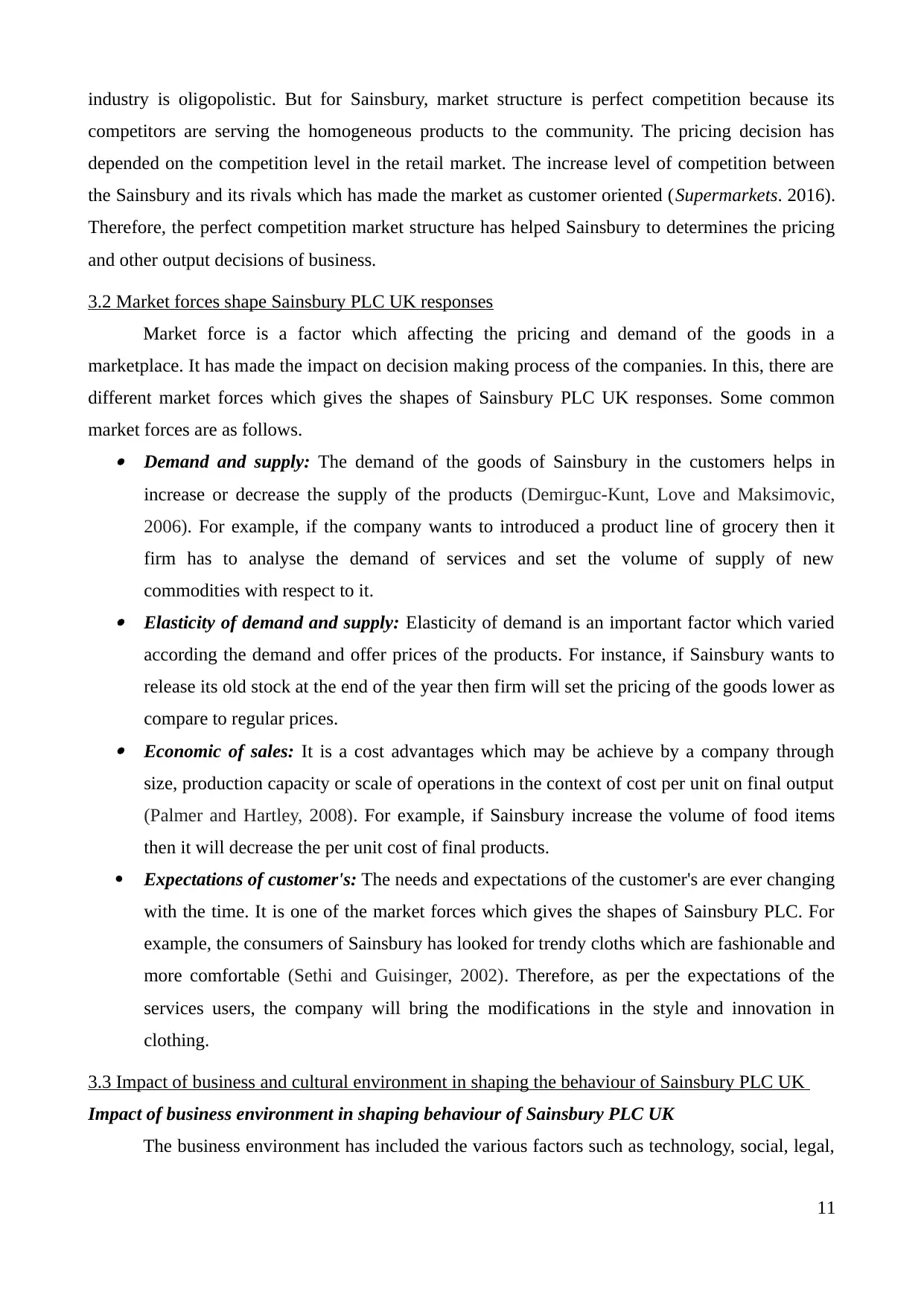
industry is oligopolistic. But for Sainsbury, market structure is perfect competition because its
competitors are serving the homogeneous products to the community. The pricing decision has
depended on the competition level in the retail market. The increase level of competition between
the Sainsbury and its rivals which has made the market as customer oriented (Supermarkets. 2016).
Therefore, the perfect competition market structure has helped Sainsbury to determines the pricing
and other output decisions of business.
3.2 Market forces shape Sainsbury PLC UK responses
Market force is a factor which affecting the pricing and demand of the goods in a
marketplace. It has made the impact on decision making process of the companies. In this, there are
different market forces which gives the shapes of Sainsbury PLC UK responses. Some common
market forces are as follows. Demand and supply: The demand of the goods of Sainsbury in the customers helps in
increase or decrease the supply of the products (Demirguc-Kunt, Love and Maksimovic,
2006). For example, if the company wants to introduced a product line of grocery then it
firm has to analyse the demand of services and set the volume of supply of new
commodities with respect to it. Elasticity of demand and supply: Elasticity of demand is an important factor which varied
according the demand and offer prices of the products. For instance, if Sainsbury wants to
release its old stock at the end of the year then firm will set the pricing of the goods lower as
compare to regular prices. Economic of sales: It is a cost advantages which may be achieve by a company through
size, production capacity or scale of operations in the context of cost per unit on final output
(Palmer and Hartley, 2008). For example, if Sainsbury increase the volume of food items
then it will decrease the per unit cost of final products.
Expectations of customer's: The needs and expectations of the customer's are ever changing
with the time. It is one of the market forces which gives the shapes of Sainsbury PLC. For
example, the consumers of Sainsbury has looked for trendy cloths which are fashionable and
more comfortable (Sethi and Guisinger, 2002). Therefore, as per the expectations of the
services users, the company will bring the modifications in the style and innovation in
clothing.
3.3 Impact of business and cultural environment in shaping the behaviour of Sainsbury PLC UK
Impact of business environment in shaping behaviour of Sainsbury PLC UK
The business environment has included the various factors such as technology, social, legal,
11
competitors are serving the homogeneous products to the community. The pricing decision has
depended on the competition level in the retail market. The increase level of competition between
the Sainsbury and its rivals which has made the market as customer oriented (Supermarkets. 2016).
Therefore, the perfect competition market structure has helped Sainsbury to determines the pricing
and other output decisions of business.
3.2 Market forces shape Sainsbury PLC UK responses
Market force is a factor which affecting the pricing and demand of the goods in a
marketplace. It has made the impact on decision making process of the companies. In this, there are
different market forces which gives the shapes of Sainsbury PLC UK responses. Some common
market forces are as follows. Demand and supply: The demand of the goods of Sainsbury in the customers helps in
increase or decrease the supply of the products (Demirguc-Kunt, Love and Maksimovic,
2006). For example, if the company wants to introduced a product line of grocery then it
firm has to analyse the demand of services and set the volume of supply of new
commodities with respect to it. Elasticity of demand and supply: Elasticity of demand is an important factor which varied
according the demand and offer prices of the products. For instance, if Sainsbury wants to
release its old stock at the end of the year then firm will set the pricing of the goods lower as
compare to regular prices. Economic of sales: It is a cost advantages which may be achieve by a company through
size, production capacity or scale of operations in the context of cost per unit on final output
(Palmer and Hartley, 2008). For example, if Sainsbury increase the volume of food items
then it will decrease the per unit cost of final products.
Expectations of customer's: The needs and expectations of the customer's are ever changing
with the time. It is one of the market forces which gives the shapes of Sainsbury PLC. For
example, the consumers of Sainsbury has looked for trendy cloths which are fashionable and
more comfortable (Sethi and Guisinger, 2002). Therefore, as per the expectations of the
services users, the company will bring the modifications in the style and innovation in
clothing.
3.3 Impact of business and cultural environment in shaping the behaviour of Sainsbury PLC UK
Impact of business environment in shaping behaviour of Sainsbury PLC UK
The business environment has included the various factors such as technology, social, legal,
11
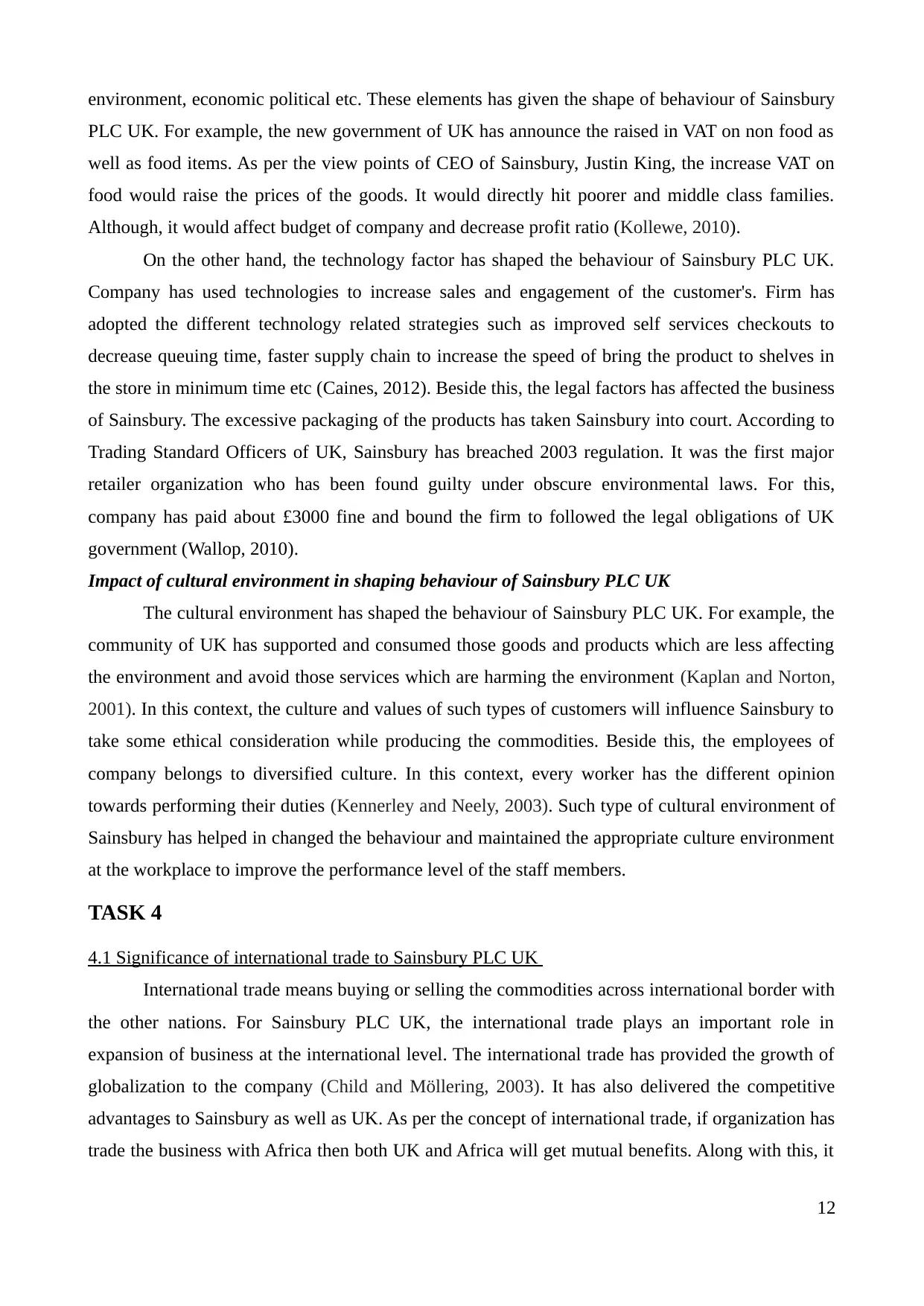
environment, economic political etc. These elements has given the shape of behaviour of Sainsbury
PLC UK. For example, the new government of UK has announce the raised in VAT on non food as
well as food items. As per the view points of CEO of Sainsbury, Justin King, the increase VAT on
food would raise the prices of the goods. It would directly hit poorer and middle class families.
Although, it would affect budget of company and decrease profit ratio (Kollewe, 2010).
On the other hand, the technology factor has shaped the behaviour of Sainsbury PLC UK.
Company has used technologies to increase sales and engagement of the customer's. Firm has
adopted the different technology related strategies such as improved self services checkouts to
decrease queuing time, faster supply chain to increase the speed of bring the product to shelves in
the store in minimum time etc (Caines, 2012). Beside this, the legal factors has affected the business
of Sainsbury. The excessive packaging of the products has taken Sainsbury into court. According to
Trading Standard Officers of UK, Sainsbury has breached 2003 regulation. It was the first major
retailer organization who has been found guilty under obscure environmental laws. For this,
company has paid about £3000 fine and bound the firm to followed the legal obligations of UK
government (Wallop, 2010).
Impact of cultural environment in shaping behaviour of Sainsbury PLC UK
The cultural environment has shaped the behaviour of Sainsbury PLC UK. For example, the
community of UK has supported and consumed those goods and products which are less affecting
the environment and avoid those services which are harming the environment (Kaplan and Norton,
2001). In this context, the culture and values of such types of customers will influence Sainsbury to
take some ethical consideration while producing the commodities. Beside this, the employees of
company belongs to diversified culture. In this context, every worker has the different opinion
towards performing their duties (Kennerley and Neely, 2003). Such type of cultural environment of
Sainsbury has helped in changed the behaviour and maintained the appropriate culture environment
at the workplace to improve the performance level of the staff members.
TASK 4
4.1 Significance of international trade to Sainsbury PLC UK
International trade means buying or selling the commodities across international border with
the other nations. For Sainsbury PLC UK, the international trade plays an important role in
expansion of business at the international level. The international trade has provided the growth of
globalization to the company (Child and Möllering, 2003). It has also delivered the competitive
advantages to Sainsbury as well as UK. As per the concept of international trade, if organization has
trade the business with Africa then both UK and Africa will get mutual benefits. Along with this, it
12
PLC UK. For example, the new government of UK has announce the raised in VAT on non food as
well as food items. As per the view points of CEO of Sainsbury, Justin King, the increase VAT on
food would raise the prices of the goods. It would directly hit poorer and middle class families.
Although, it would affect budget of company and decrease profit ratio (Kollewe, 2010).
On the other hand, the technology factor has shaped the behaviour of Sainsbury PLC UK.
Company has used technologies to increase sales and engagement of the customer's. Firm has
adopted the different technology related strategies such as improved self services checkouts to
decrease queuing time, faster supply chain to increase the speed of bring the product to shelves in
the store in minimum time etc (Caines, 2012). Beside this, the legal factors has affected the business
of Sainsbury. The excessive packaging of the products has taken Sainsbury into court. According to
Trading Standard Officers of UK, Sainsbury has breached 2003 regulation. It was the first major
retailer organization who has been found guilty under obscure environmental laws. For this,
company has paid about £3000 fine and bound the firm to followed the legal obligations of UK
government (Wallop, 2010).
Impact of cultural environment in shaping behaviour of Sainsbury PLC UK
The cultural environment has shaped the behaviour of Sainsbury PLC UK. For example, the
community of UK has supported and consumed those goods and products which are less affecting
the environment and avoid those services which are harming the environment (Kaplan and Norton,
2001). In this context, the culture and values of such types of customers will influence Sainsbury to
take some ethical consideration while producing the commodities. Beside this, the employees of
company belongs to diversified culture. In this context, every worker has the different opinion
towards performing their duties (Kennerley and Neely, 2003). Such type of cultural environment of
Sainsbury has helped in changed the behaviour and maintained the appropriate culture environment
at the workplace to improve the performance level of the staff members.
TASK 4
4.1 Significance of international trade to Sainsbury PLC UK
International trade means buying or selling the commodities across international border with
the other nations. For Sainsbury PLC UK, the international trade plays an important role in
expansion of business at the international level. The international trade has provided the growth of
globalization to the company (Child and Möllering, 2003). It has also delivered the competitive
advantages to Sainsbury as well as UK. As per the concept of international trade, if organization has
trade the business with Africa then both UK and Africa will get mutual benefits. Along with this, it
12
⊘ This is a preview!⊘
Do you want full access?
Subscribe today to unlock all pages.

Trusted by 1+ million students worldwide
1 out of 19
Related Documents
Your All-in-One AI-Powered Toolkit for Academic Success.
+13062052269
info@desklib.com
Available 24*7 on WhatsApp / Email
![[object Object]](/_next/static/media/star-bottom.7253800d.svg)
Unlock your academic potential
Copyright © 2020–2025 A2Z Services. All Rights Reserved. Developed and managed by ZUCOL.





